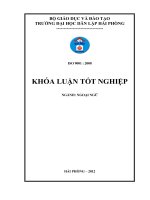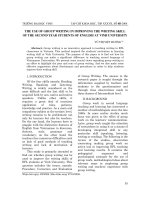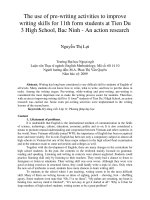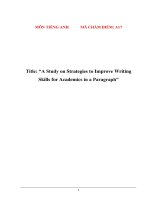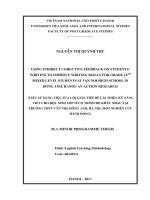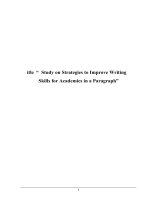A study on strategies to improve writing skills for academics in a paragraph
Bạn đang xem bản rút gọn của tài liệu. Xem và tải ngay bản đầy đủ của tài liệu tại đây (529.69 KB, 10 trang )
itle “ Study on Strategies to Improve Writing
Skills for Academics in a Paragraph”
1
A Study On Strategies To Improve Writing Skills For Academics
In A Paragraph
Part A. INTRODUCTION
Part B. DEVELOPMENT
I. RELATED LITERATURE REVIEW
I.1. The definition of the word “Academic”
I.2. The definition of Academic writing
I.3. The organization of a paragraph in general
II. FINDINGS ON STRATEGIES TO IMPROVE WRITING SKILLS
FOR ACADEMICS IN A PARAGRAPH
II.1. Strategies of pre-writing
II.1.1. The audience
II.1.2. The purpose
II.1.3. The format
II.2. Strategies of writing process
II.2.1. Spelling, punctuation, and grammar
II.2.1.1. Spelling
II.2.1.2. Punctuation
II.2.1.3. Grammar
II.2.2. Style and tone
Part C. CONCLUSION
2
A Study On Strategies To Improve Writing Skills For Academics
In A Paragraph
Part A. INTRODUCTION
Obviously, the last of the four skills speaking, listening, reading, and writing has
been grossly neglected in audio-lingual approach to language teaching.
Especially, the importance of writing is not considered at its factual role. There
have been a lot of neglect of writing in foreign language teaching and the lack of
interests in it. John Carroll’s “Research on Teaching in Foreign Language”
reports research on grammar, pronunciation, vocabulary, and reading but none
on writing reflecting the interests of language teachers. This paper is intended as
a plea to restore teaching writing to its proper place in general, and the
importance of writing a good paragraph in particular.
It is clear that a good essay have components from good paragraphs. Good
paragraphs are a key component of good academic writing. Therefore, this study
explains on strategies to improve writing skills for academics in a paragraph.
The first part of the paper seeks to examine the importance of how to write a
good paragraph in teaching foreign language. The second part of the paper deals
with the related literature review about the definition of academic writing and
how is the organization of a paragraph in general. At the same time, some
suggested strategies also are given to solve difficulties in writing an effective
paragraph.
Part B. DEVELOPMENT
I. RELATED LITERATURE REVIEW
I.1.The definition of the word “ cademic”
According to Oxford Advanced Learners Dictionary, the definition of
“Academic” is connected with education, especially studying in school and
universities involving a lot of reading and studying rather than practical and
3
technical skills in order to be good at one or many subjects. Generally, the
concept of “Academic” has no conventions in narrow lengths; it is commonly
used in both of life situations as well as a variety of studies such as letter, report,
notice or even diary. Basing on the definition of “Academic”, the set expression
“academic writing” is seen as the use of formal and solemn language in a piece
of writing often found in scientific activities.
I.2. The definition of Academic writing
As for Alice Oshima and Ann Hogue in “Writing Academic English”,
“academic witing” as the name implies, is the kind of writing that you are
required to do in college or university. It differs from other kinds of writing
(personal, literacy, journalistic, business, etc).
In academic writing, there is a variety in kinds of pieces of writing such as:
- Notes (lectures)
- Compositions (included the three parts as: Introduction, Development,
and Conclusion)
- Reports (factual pieces in basic sciences, history, psychology, and so on)
- Projects (concentrated on researches)
- Journal articles
- Thesis and Dissertation
With the view of improving writing skills in term of academic aspects, this study
only concentrates on strategies of how to get an effective paragraph in academic
style and tone.
I.3. The organization of a paragraph in general
The organization of a paragraph is rated at the complete when it contains three
elements of paragraph structure: a topic sentence, supporting sentences and a
concluding sentence. Furthermore, a paragraph is considered effective when it
contains time-order transition signals such as: First, Second, and Third…
An English paragraph is like a sandwich, the topic and concluding sentences are
the top and bottom pieces of bread, and the supporting sentence are the filling.
4
The bread hold the sandwich together, and the supporting sentences are the meat
and cheese. What is contained or the implication of the writer should be in the
summing-up or re-emphasized in the concluding sentence; this seems to be
repetitious, yet clear academic writing in English requires all of these parts.
II. FINDINGS ON STRATEGIES TO IMPROVE WRITING SKILLS
FOR ACADEMIC IN A PARAGRAPH
II.1. Strategies of pre-writing
It is obvious that each paragraph is used to bring certain information to the
readers; through the channel of writing, the writer gives a direction of readers’
attention to his idea or thoughts; therefore, the elements of Academic writing are
centred upon the factors as the writing’s purpose and the audience. At the first
stage, the writer always starts with the question who the audience is and which
information should be contained in the paragraph. In a natural way, the prewriting steps of Academic writing often take notice on audience, the purpose
first and then to the format of the paragraph.
II.1.1.The audience
In order to write a paragraph effectively, the audience factor is seen as the most
important one of the pre-writing strategies because of its main characteristics,
that is, the people who read the written materials is the receiver of given
information. For example, when writing a letter to a friend, the writer will
express his/her intimate emotions and words to his/her friend; on the contrary, to
the letter on business, the words and the style of language are used in the formal
because of the characteristic of the relationship.
The evidences show that each of written materials has its own audience
regardless of the difference of categories such as history, political science,
psychology, or English language exams. Therefore, knowing clearly who the
audience is will help the sent message reach the goal of communicating in an
effective way, especially in academic writing of a paragraph.
5
I.1.2. The purpose
Not only the author should be concerned with the audience, but should be also
concerned with purpose and the topic of the writing. To each kind of writing,
there should be specific and clear purpose with the aims of satisfying the
reader’s entertainments. In academic writing, the purpose are most often
explained, that the reason why the purpose decide which field of study the topic
is related, for example, an article that tries to persuade nuclear power plants are
unsafe has an notice on the physics more than the evidences in politics or the
perspective in the future of a Eastern country using it as a weapon. As a matter
of fact, the author often raises the questions on their minds before starting to
write just as: “Write for whom?”, “For which purpose to write” and so the last
question is that “What to write?”. Dealing with these questions helps the writer
has an over-look on the matter that he/she is facing at, the position of the
standing view becomes more objective and realistic.
I.1.3. The format
Apart from the audience and the purpose factors, there still exists one of the
main elements making pre-writing strategies is that the format of a paragraph in
academic writing. It is obvious that without the factor of audience or purpose,
the effectiveness of the paragraph will be loosened much more than ever;
however, the format is also played an important role in forming a paragraph of
academic standardizations.
For example, the topic of an article is about nuclear weapon, the journalist has to
decide which form/organization and style to write, the persuasive article is
organized in one way, but the expository should be arranged in another way, that
is the so-called format of the piece of writing.
The format of the piece of writing in an English exam is quite different from an
essay in a scientific journal or a report in the inter-disciplinary research;
6
therefore, the last step that needs to be determined is the format of the writing in
such a way as to match the requirements of the early given purpose.
II.2. Strategies of writing process
II.2.1. Spelling, punctuation, and grammar
II.2.1.1. Spelling
When writing a paragraph, spelling mistake is one of realizable errors for the
reason of English spelling is notoriously difficult to master for native speakers
and language learners alike. Because English developed from several different
language families, and because it so easily absorbs new words from other
languages even today, the English language has many different ways to spell
the same sound and many different ways to pronounce the same spelling. But
improving English spelling is not impossible, with some patience such as using a
good dictionary, learning the standard pronunciations for frequently misspelled
words, watching out for homophones, near-homophones, and other easily
confusable words,… spelling mistakes can be overcome.
Example 1:
Some common misspellings derive not from difficult combinations of letters but
from pronunciations that do not reflect the word’s spelling.
The word mischievous, for example, is often misspelled because of the common
pronunciation "miss CHEEVY us." Learning the standard pronunciation "MISS
chiv us" will aid you in properly spelling the word.
Example 2:
Many English words have identical or similar pronunciations but different
spellings. Using the wrong word of a homophone pair is one of the most
common spelling pitfalls for all writers. Learn to check these types of commonly
misspelled words carefully during the proofreading.
7
accept/except
discreet/discrete
oral/aural
adverse/averse
elude/allude
palette/palate
affect/effect
eminent/imminent
populace/populous
altar/alter
ensure/insure
precede/proceed
boarder/border
elicit/illicit
prescribe/proscribe
broach/brooch
hanger/hangar
principle/principal
callous/callus
illusion/allusion
right/write/rite
casual/causal
incidents/incidence
stationary/stationery
censor/censure
isle/aisle
tenet/tenant
cite/site/sight
its/it's
there/their/they're
climactic/climatic
led/lead
tortuous/torturous
compliment/complement liquor/liqueur
waver/waiver
conscience/conscious
lose/loose
whose/who's
desert/dessert
naval/navel
your/you're
II.2.1.2. Punctuation
In order to write an effective paragraph, writers need to learn certain aspects of
the English punctuation system, such as the way to punctuate direct speech. In
general; however, the most serious of punctuation mistakes are made not only
by ESL students, but by native speakers too. These mistakes are due to the lack
of a clear understanding of what a sentence is, and they result in fragments
(incomplete sentences) or run-ons ('sentences' that do not end when they
should).
Punctuation mistakes can often be spotted if the student reads the writing
aloud. If a natural pause in the reading does not correspond with, say, a comma
or a full-stop in the written text, then it is likely that the punctuation is faulty.
Important writing should be given to a competent native-speaker to check.
8
Extensive reading, especially of non-fiction, both in English and the mother
tongue, will help students understand the concept of the sentence as the basis
of good writing.
II.2.1.3. Grammar
Grammar mistakes are the next type of error commonly made by ESL students.
For example, learners often do not choose the correct English verb tense for
expressing an idea or do not use it in its correct form. They may fail to use the
articles (a/the) correctly, or place words in the wrong order in a sentence.
Some grammar mistakes are easy for learners to correct themselves,
particularly if they read their writing aloud. Other grammar mistakes are not
easy to find; however, because the learner simply does not yet know the
correct way to express an idea in English. Looking in a grammar book will not
often help in such circumstances - the best thing to do is to ask a native
speaker or a teacher to check the writing.
In the long term most grammar mistakes will disappear by themselves,
particularly if the learner does extensive reading in English
II.2.2. Style and tone
As a matter of course, the tone and the style of a piece of writing are determined
more by its intended audience and the purpose than by its subjects. The tone of
the writing is seen as the author’s attitude, and the style is the way of the piece
of writing. In academic writing, the style is denoted as the rhetorical form, in
which, the composition should be considered in a variety of styles such as
formal, reasoned, elaborate, serious, objective, unbiased, and knowledgeable.
The author can combine many styles in a composition to make his writing more
informative and persuasive, for example, a scientific article should be elaborate
and reasoned, objective, and unbiased; if possible, explained words in the article
should not be terminology because the intended audience, the general public
9
might not understand highly technical or subjective words. In general, the tone
and the style of academic writing are chosen in formal and rhetorical form.
Part C. CONCLUSION
Writing, particularly academic writing is not easy, that is, it takes study and
practice to develop this skill. For both native speaker and new learners of
English, it is important to note that writing is a process, not a “product”. This
means a piece of writing, whether it is a composition for writing a paragraph or
even an essay, is never complete; that is, it is always possible to review and
revise, and review and revise again. This needs a nonstop attempt for a very long
time, so that to start up, the recommended suggestion is to build up with each
branch of an essay, each paragraph in particular.
Due to the condition of sourcing materials and several different reasons, this
study still contains some shortcomings regardless of the willing of the writer; yet
it is not more than enough to remind that: if the writer knows how to write a
good paragraph, he/she will know how to combine and expand paragraph to
build essays.
10

